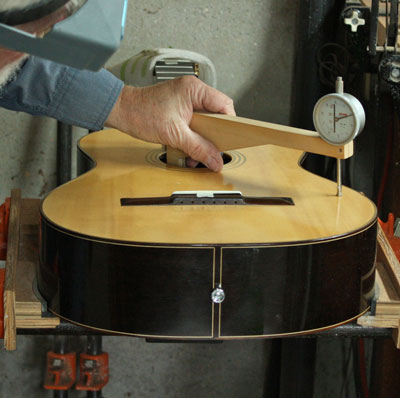Are you tired of strumming your guitar like a nervous squirrel on a caffeine binge? Ready to ditch the awkward flailing and master the art of expressive strumming like a boss? Well, grab your pick and get ready to rock and roll, because we’re about to show you how to unleash your inner strumming superhero! It’s time to stop being a strumming disaster and start strumming like a pro. So buckle up, buttercup, because we’re about to take your strumming game to a whole new level!
Contents
- 1 Understanding the Foundations of Expressive
- 2 Exploring the Dynamics of Strumming Patterns for Emotional Impact
- 3 Incorporating Various Strumming Speeds to Convey Musical Mood
- 4 The Role of Hand Position and Angle in Crafting Unique Sounds
- 5 Transcending Basic Strumming Through Advanced Rhythmic Variations
- 6 Exploring the Depths of Rhythmic Guitar Playing
- 7 Harnessing the Power of Silence and Rests in Strumming Sessions
- 8 Cultivating Your Personal Strumming Style for Expressive Performance
- 9 FAQs
- 10 Now Go Rock Out Like a Pro!
Understanding the Foundations of Expressive Guitar Pick Keeps Slipping”>Strumming Techniques
When it comes to expressive strumming techniques, it’s all about finding your groove on the guitar. Let’s break it down into the essential foundations that will have you strumming like a rockstar in no time!
First up, we have rhythm. This is the heartbeat of your strumming technique. Get your foot tapping and your fingers flying in time with the music. Remember, it’s not just about hitting the strings – it’s about feeling the rhythm deep in your soul.
Next, let’s talk about fluidity. You want your strumming to be smooth like butter, not choppy like a lumberjack with a rusty axe. Practice transitioning between chords seamlessly, letting your fingers glide effortlessly across the strings.
- Dynamic range is another crucial aspect of expressive strumming. Don’t be afraid to play softly one moment and then unleash a thunderous crescendo the next. Let your emotions guide your strumming hand, and watch as your music comes alive.
- Lastly, nuance is key. Pay attention to the subtle details in your playing – the slight pauses, the gentle accents, the delicate muting. It’s these nuances that will set your strumming apart from the rest.

Exploring the Dynamics of Strumming Patterns for Emotional Impact
Strumming patterns may seem like simple movements of the hand, but in reality, they hold the power to evoke a wide range of emotions in listeners. Here, we dive deep into the art of strumming to uncover the secrets behind its emotional impact.
First and foremost, let’s talk about the importance of tempo in strumming patterns. A slow, gentle strum can convey feelings of melancholy and longing, while a fast, aggressive strumming pattern can evoke excitement and intensity. The tempo at which you strum can make or break the emotional impact of a song, so choose wisely!
Next, let’s discuss variation in strumming patterns. Mixing up your strumming techniques by incorporating pauses, dynamics, and accents can add depth and complexity to your music. Try experimenting with different patterns to see how they affect the overall emotional tone of your song.
Lastly, don’t underestimate the power of simplicity. Sometimes, a straightforward strumming pattern can be just as emotionally impactful as a complex one. Remember, it’s not always about how many notes you play, but how you play them that truly resonates with your audience. So, grab your guitar, experiment with different strumming patterns, and let your emotions flow through your music!

Incorporating Various Strumming Speeds to Convey Musical Mood
When it comes to playing the guitar, strumming speed can make a huge difference in how a song is perceived. By incorporating various strumming speeds, you can effectively convey different musical moods to your audience. Let’s take a look at how you can use this technique to bring your music to life!
First off, let’s talk about slow strumming. Slow strumming can create a sense of longing or melancholy in your music. It’s perfect for those heart-wrenching ballads or soulful blues tunes. To achieve the desired effect, try strumming at a slow and steady pace, allowing each note to ring out and linger in the air. This will give your music a sense of depth and emotion that will resonate with your listeners.
On the flip side, fast strumming can bring a sense of energy and excitement to your music. Imagine playing a high-tempo punk rock song with lightning-fast strumming – it’s sure to get the crowd jumping and moshing along! To nail this technique, try using quick, aggressive strums to create a sense of urgency and intensity in your music.
And let’s not forget about medium-paced strumming. This versatile strumming speed can be used to convey a range of moods, from laid-back and relaxed to upbeat and optimistic. Experiment with different rhythms and patterns to find the perfect balance between energy and emotion. Remember, the key is to match your strumming speed to the mood you want to convey – so don’t be afraid to mix things up and get creative!

The Role of Hand Position and Angle in Crafting Unique Sounds
When it comes to crafting unique sounds on your instrument, hand position and angle play a crucial role. It’s not just about hitting the right notes, it’s about how you hit them!
By adjusting the position and angle of your hands, you can create a whole new world of sounds. Need a mellow, soothing tone? Try cupping your hands around the strings and plucking gently. Want to rock out with some gritty distortion? Angle your hands aggressively and attack those strings with reckless abandon!
Don’t be afraid to experiment with different hand positions and angles. The possibilities are endless! Here are a few tips to get you started:
- Flat palm: For a smooth, even sound
- Curled fingers: Ideal for fast picking
- Tilted wrist: Adds a funky, off-kilter vibe

Transcending Basic Strumming Through Advanced Rhythmic Variations
Exploring the Depths of Rhythmic Guitar Playing
So you’ve mastered the basic strumming patterns and you’re itching to take your guitar playing to the next level? Well, my friend, it’s time to delve into the world of advanced rhythmic variations. Buckle up, because we’re about to take a wild ride through a musical labyrinth of complex rhythms and unpredictable beats.
One of the keys to transcending basic strumming is learning how to incorporate syncopation into your playing. This fancy term simply means accenting the off-beats instead of the standard downbeats. It creates a sense of tension and release in your music, adding layers of complexity that will keep your listeners on the edge of their seats.
Another way to spice up your strumming is by experimenting with different time signatures. Sure, 4/4 is all well and good, but have you ever tried playing in 7/8 or 5/4? It’s like navigating a musical obstacle course, with unexpected twists and turns that will challenge your rhythmic instincts in the best way possible.
And let’s not forget about the magic of polyrhythms – the art of playing multiple rhythms simultaneously. Picture this: while your right hand is strumming a steady 4/4 pattern, your left hand is tapping out a syncopated 6/8 groove. It’s like patting your head and rubbing your belly at the same time, but with way more musical flair.
Harnessing the Power of Silence and Rests in Strumming Sessions
When it comes to strumming sessions, silence and rests are often overlooked. But let me tell you, they are more powerful than you think!
Think of silence like the pause button on your favorite show – it adds drama and anticipation. By incorporating strategic pauses into your strumming, you can create tension and release that will keep your audience on the edge of their seats.
Rests are like the seasoning in your favorite dish – they add flavor and nuance. By strategically placing rests in your strumming patterns, you can create a dynamic and engaging performance that will leave your listeners wanting more.
So next time you pick up your guitar, remember to harness the power of silence and rests. Your strumming sessions will never be the same!
Cultivating Your Personal Strumming Style for Expressive Performance
When it comes to strumming your guitar, it’s all about finding your own unique style that allows you to express yourself fully in your performances. Here are a few tips to help you cultivate your personal strumming style:
- Experiment with different rhythms: Don’t be afraid to try out new strumming patterns and rhythms. Mix it up and see what feels right for you. You might discover a funky groove or a steady beat that really speaks to your soul.
- Play with dynamics: Think of your guitar strumming like a rollercoaster ride – you want to have highs and lows to keep your audience engaged. Try playing softly and then ramping up the intensity for a powerful crescendo. It’s all about creating an emotional journey with your music.
- Embrace your mistakes: Sometimes the best strumming moments come from happy accidents. Don’t stress if you hit a wrong note or mess up a pattern. Just roll with it and see where it takes you. You might stumble upon a new strumming technique that becomes your signature move.
Remember, the key to cultivating your personal strumming style is to have fun and let your creativity run wild. So don’t be afraid to unleash your inner strumming rockstar and show the world what you’ve got!
FAQs
How can I add dynamics to my strumming?
Well, my dear strummer, the key to adding dynamics is mastering the art of varying your strumming intensity. Play around with strumming harder or softer, mixing it up to create a dynamic and interesting sound that will captivate your audience.
What are some techniques to improve my strumming accuracy?
Ah, accuracy is crucial when it comes to strumming. One handy tip is to focus on your right-hand technique. Make sure you’re using the proper wrist motion and keep a steady rhythm. Practice makes perfect, so keep strumming away until you hit that sweet spot of accuracy.
How can I incorporate different strumming patterns into my playing?
Oh, the wonderful world of strumming patterns! The key here is to start simple and gradually work your way up to more complex patterns. Practice each pattern slowly and deliberately until it becomes second nature. Don’t be afraid to experiment and get creative with your strumming – the world is your strumming oyster!
What role does rhythm play in expressive strumming?
Rhythm is the heartbeat of expressive strumming, my friend. It sets the tone and mood of your playing, so it’s essential to nail down your rhythm. Practice with a metronome to keep your timing in check and experiment with different rhythmic patterns to really make your strumming pop.
How can I use dynamics to convey emotion in my playing?
Ah, emotions and music go hand in hand like peanut butter and jelly. To convey emotion in your playing, focus on using dynamics to build tension and release throughout your strumming. Play with feeling and let your emotions guide your strumming – your audience will thank you for it!
Now Go Rock Out Like a Pro!
So there you have it, you are now armed with all the knowledge and techniques you need to master the art of expressive strumming. It’s time to grab your guitar, crank up the volume, and let your inner rock star shine! Remember, practice makes perfect, so don’t be afraid to experiment and make mistakes along the way. Keep strumming, keep grooving, and most importantly, keep having fun with your music. Rock on! 🎸🤘



